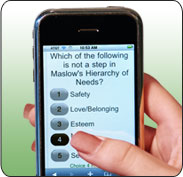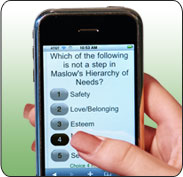Did You Know . . .The Power of a Student Response System

The YouTube video "Did You Know?" popularized this question and shed light on our rapidly changing world through startling statistics regarding MySpace, internet connectivity and the growth of the world's knowledge. Several spin off videos such as the TeacherTube "Connected Classroom" revealed the substantial digital divide between the evolving world technologies and the antiquated methodologies still persistent in the majority of America's classrooms.

One of the more powerful statements in the "Did You Know" videos is that we are preparing students for jobs that do not yet exist. How we accomplish this impossible mission requires new and innovative practices that engage digital natives rather than power them down in their primary learning environment...our classrooms. Student response systems are a research proven technology that engages students and can help narrow the gap between the world's evolution that which is occurring in our educational system.
Did you know that student response systems can change assessing for grades to assessing for learning? Traditional teaching methods separate instruction from assessment. Student response systems merge assessment with instruction allowing for differentiated instruction, instant feedback and maximized learning.
Did you know that student response systems engage all students for all questions ? The use of clickers guarantees the participation of the shy, confused, bright, distractible, or underperforming student. The teacher can easily identify students who may need additional instruction.
Did you know that student response systems have a decade of research that has revealed consistent evidence that the use of clickers increases student achievement? The current body of research includes conclusions that support student response systems as a technology that increase engagement, feedback, and achievement.
Did you know that the price of a Turning Technologies student response clicker is one third the cost of the average required high school calculator? Since the clicker can be used in all classes all the time, the return on investment is at least five times greater.
Did you know that if student response systems were as prevalent as chalkboards, our number of failing schools which is nearly 22,000 could be significantly reduced? Our current trend lines in the US reveal that up to 99% of our schools will not be meeting AYP in the year 2014. Change is required to reverse this trend.
Tools and ideas to transform education. Sign up below.
Did you know that a student response system can be used for implementing a school improvement plan, Response to Intervention program, educational gaming or even attendance reporting? When used daily and weekly, this technology facilitates universal screening, progress monitoring, and provides that data necessary for value added analysis.
Student response systems are still an emerging technology. The potential of these systems has not been fully explored, and they are seldom implemented as one kit per classroom, which studies have shown to yield the highest results. In the Sartori, 2007 study on the relationship of ongoing assessment on student achievement, the quantitative findings of this study were significantly positive for the use of electronic SRS. All of the 5 classes scored significantly higher on the post-test than on the pre-test. All 5 teachers who completed the post implementation survey responded in support of the SRS as a tool that promotes learning and improves their overall teaching effectiveness. All students reported that learning was more fun using the SRS. These findings were consistent with the research conducted by Hines which focused on the application of the SRS to promote interactive learning. The research revealed that “after first-semester final exams, the science and math students scored an average of four to six percentage points higher on test scores” (Hines, 2005, p. 41).
Additional literature supports the motivational and engagement factors of SRS. In “Helping Students Learn with Classroom Response Systems”, Pelton and Pelton (2005) reviewed the pedagogical implications of SRSs. These systems provide an exception tool for assessment and engagement. According to Pelton and Pelton, “by engaging the students in producing their own answers, it is expected that students will be even more likely to ‘buy in’ and think deeply about the question”
(p.1554). The researchers suggested that SRSs have the potential to engage learners, and given the decreasing cost of these systems, teachers should consider integrating SRSs in their classrooms as a new approach to the instructional process.
Student response systems should evolve as transparent tools in the learning process and provide a convenient method to embed assessment in instructional delivery. Did you know that once this technology becomes a core component of daily assessment, the following positive results are expected: (a) immediate corrective feedback to students, (b)differentiated instruction, (c) specific group tracking, (d) individualized student reporting, (e)data-driven instructional decisions, (f) decreased student testing anxiety, (g) increased student engagement, and (h) motivation of students to participate in the learning process. Now we know that power of student response systems and will look for further advancements with this technology.
REFERENCES
Hines, L. (2005). Interactive learning environment keeps Modesto students engaged. T H E Journal, 33(2), 40–41.
Pelton, T., & Pelton, F. L. (2005). Helping students learn with classroom response systems. In J. Lang (Ed.), Society for Information Technology and Teacher Education International Conference (pp. 1554–1559). Chesapeake, VA: Association for the Advancement of Computing in Education.
Dr. Tina Sartori is the educational consultant for Turning Technologies and her primary role has been launching a new series of programs called TurnItUp which are designed to accomplish broad educational goals using student response technology. The initial programs will include the Turn Up Achievement Program which is a systemic approach to raising student achievement, Turn Up Learning which is a comprehensive Response to Intervention program and Turn Up Engagement which offers schools a research based approach to implementing educational gaming.
